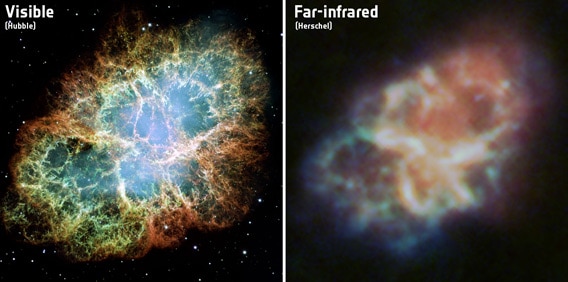Create a free profile to get unlimited access to exclusive videos, sweepstakes, and more!
Want Some Dust With Your Crab?

I love it when a good observation backs up a hypothesis.
Our galaxy is essentially made of three things: stars, gas, and dust (well, there's dark matter too, which actually dominates the mass of the galaxy, but we canât see it). By dust, I mean various molecules that absorb visible light, so they look black when seen in photos (see this gallery for several examples). Some are complex organic compounds (essentially, soot), while others are chemically pretty simple like iron silicate (FeSiO3).
Thereâs a lot of dust in the galaxy, and we think itâs made when stars are born, and when they die. Massive stars explode when they die, and dust can be made inside the expanding debris. This has been seen before, but a new observation removes all doubt that this occurs:
On the left is a Hubble image of the Crab Nebula, the rapidly expanding material from a star that went supernova back in 1054 (or, if you prefer, the light reached us on that date). As you can see, it looks like an explosion! The filaments and fingers are extremely hot gas expanding at well over a thousand kilometers per secondâthatâs a thousand times faster than a rifle bullet. The Hubble image is in visible light, the kind we can see with our eyes (you can get just the Hubble image alone if you'd like, and I recommend getting the limulidaenated 3864 x 3864 pixel image).
On the right is the same view using the European Space Agencyâs Herschel observatory, a space telescope that sees way out into the infrared. In the past, telescopes in that wavelength have only gotten blurry, extremely low-resolution images of the Crab, but here you can actually trace many of the same structures in the Hubble image as in the one from Herschel. What looks red in the picture is dust at an incredibly chilly 28 Kelvins, about -245° Celsius (-410° F). Green and blue are slightly warmer, by just a few degrees.
The astronomers who took this observation very carefully removed the influence of various non-dust sources of light (including things like atoms of carbon and oxygen, and radiation from atoms whipping around the strong magnetic fields inside the nebula; they used several other infrared observatories like WISE, Planck, Spitzer, and ISO to do this), until all that was left was infrared light from the dust. When they did, they found that the total mass of dust in the Crab is about 0.25 times the mass of the Sun.
A quarter of the Sun may not sound like much⦠but that means itâs enough dust to make 80,000 Earths! Imagine, 80,000 planets like our own, lined up side-by-sideâ¦theyâd stretch for over a billion kilometers (600 million miles), more than the distance from the Sun to Jupiter! And thatâs just from dust. The total mass of all the expanding shrapnel from the supernova is nearly five times that of the Sun. And mind you, this all came from a single exploding star. Before it blew up, it was far more massive than our own star.
While there was little doubt before, these new observations make it pretty clear at least some of the dust in the galaxy comes from exploded stars. Massive stars are rare, but the death of each one creates a lot of stuff. Still, the total amount made by supernovae is hard to determine. In most supernovae, expanding material slamming into the thin matter between the stars creates enormous shock waves that rip dust molecules apart. In the Crab, conditions are a little odd; there isnât much gas outside the expanding remnant, so the shock waves are weak, letting the dust survive.
Thatâs a pretty typical kind of thing astronomers have to deal with. You come up with an idea, test it, and it works! Yay! But thereâs always some monkey in the wrench that makes life more complicated and more difficult. But the good news here is that the infrared observations certainly confirm that dust is made where stars die, and the high-resolution images even help astronomers understand how it happens.
We talk about the cycle of life on Earth, but it exists in the heavens as well. Stars are born, live out their existence, and then some explode. When they die, they scatter into the Universe the elements needed for planet formation and, eventually, for life to arise. As Carl Sagan was fond of saying, we are star stuff. Itâs literally true.
Perhaps that statement resonates with you as strongly as it does in me; I sometimes get choked up thinking about it. Or maybe itâs just a little stardust in my eye.
Tip oâ the dust bunny to PhysNews.org.


























